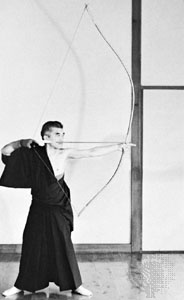kyūdō
Japanese archery
(Japanese: “way of the bow”),formerly Kyūjutsu
 (“the technique of the bow”), traditional Japanese form of archery, closely associated with Zen Buddhism. When firearms supplanted the bow and arrow in warfare, the art of archery was retained by Zen monks and some members of the Japanese upper class as a mental and physical discipline. In kyūdō the primary aim is not to hit the target, as in Western archery, but to achieve through spiritual and physical training an intense concentration on the act of shooting and a style expressing perfect serenity.
(“the technique of the bow”), traditional Japanese form of archery, closely associated with Zen Buddhism. When firearms supplanted the bow and arrow in warfare, the art of archery was retained by Zen monks and some members of the Japanese upper class as a mental and physical discipline. In kyūdō the primary aim is not to hit the target, as in Western archery, but to achieve through spiritual and physical training an intense concentration on the act of shooting and a style expressing perfect serenity.In kyūdō the kyūjūtsushi (archer) uses a traditional asymmetrical bow about 7.5 feet (2.3 m) long with a grip about one-third of the distance from the bottom. The bow is composite, made of strips of bamboo and mulberry and strung with hemp. The archer employs an Oriental, or Mongolian, grip, holding the string with the thumb supported by the fingers, and wears a special glove with a thumb reinforced by bone or wood. In the apparently continuous movements leading to the release of the arrow, there are eight recognized stages, each of which must be learned and practiced until the archer can move through them smoothly. There are many kyūdō schools in Japan, and tournaments are held annually in Kyōto and Tokyo.
- domestication
- domestic cat
- domestic partnership
- domestic pigeon
- domestic service
- domestic shorthair
- domestic system
- domestic tragedy
- domestic violence
- Domett, Alfred
- domeykite
- domicile
- dominance
- dominance hierarchy
- dominant
- Domingo Faustino Sarmiento
- Domingo Gundisalvo
- Domingo Ortega
- Domingo, Plácido
- Dominguín
- Dominica
- Dominica Channel
- Dominica, flag of
- Dominican
- Dominican Republic